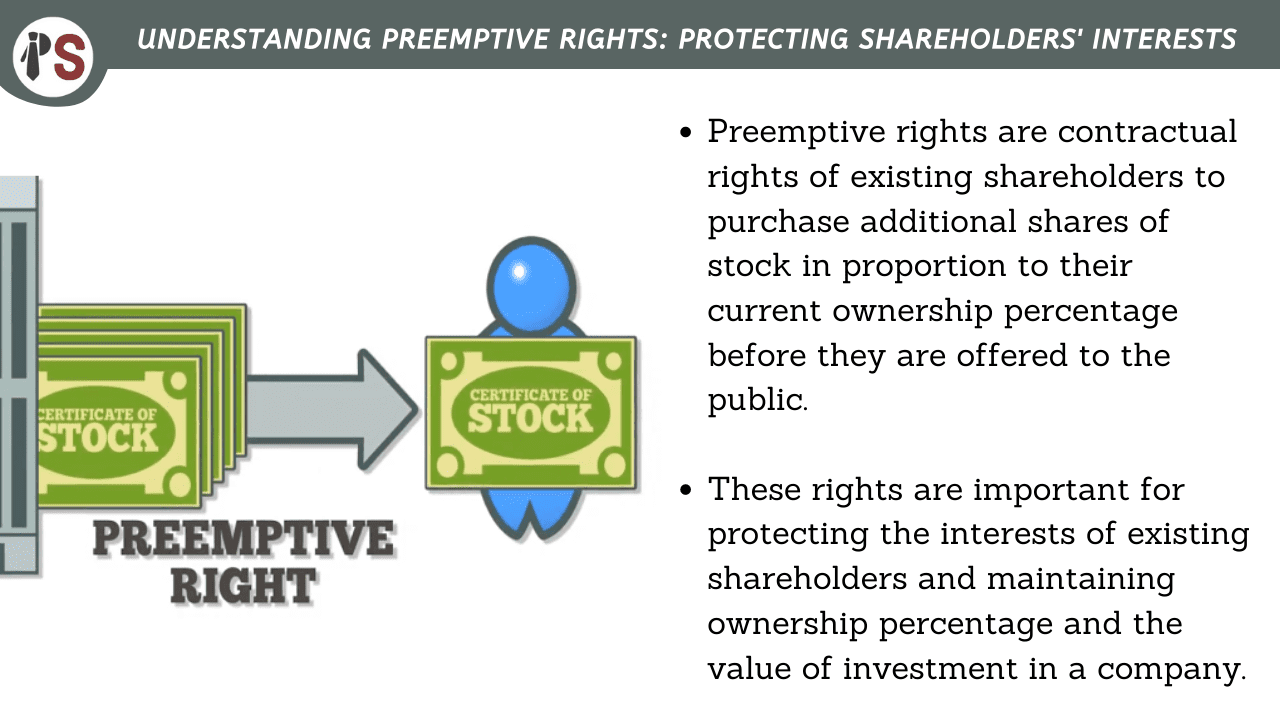
When a company issues new shares of stock, existing shareholders can experience dilution of their ownership percentage. Preemptive rights are a mechanism designed to protect shareholders from dilution by giving them the right to purchase additional shares of stock in proportion to their current ownership percentage.
Preemptive rights, also known as pre-emption rights or subscription rights, are the rights of existing shareholders to purchase additional shares of stock before they are offered to the public. These rights are typically included in a company's articles of incorporation or bylaws and can be exercised when the company issues new shares of stock.
Preemptive rights give existing shareholders the opportunity to maintain their ownership percentage and the value of their investment in the company. Without preemptive rights, existing shareholders risk having their ownership percentage diluted by new shareholders who purchase shares at a lower price than the current market value.
When a company issues new shares of stock, it must offer those shares to its existing shareholders before offering them to the public. Existing shareholders have the right to purchase additional shares of stock in proportion to their current ownership percentage. For example, if a shareholder owns 10% of a company's outstanding shares, they have the right to purchase 10% of the new shares being offered.
Preemptive rights are typically exercised through a subscription process, in which existing shareholders are given a certain period of time to purchase additional shares of stock at a specified price. If the shareholder chooses not to exercise their preemptive rights, they will experience dilution of their ownership percentage.
There are two types of preemptive rights: full preemptive rights and partial preemptive rights.
With full preemptive rights, existing shareholders have the right to purchase additional shares of stock in proportion to their current ownership percentage. This means that if a shareholder owns 10% of a company's outstanding shares, they have the right to purchase 10% of the new shares being offered.
With partial preemptive rights, existing shareholders have the right to purchase additional shares of stock, but not necessarily in proportion to their current ownership percentage. Instead, the company may offer a fixed number of shares to each shareholder, regardless of their ownership percentage.
Preemptive rights are important because they protect the interests of existing shareholders in a company. These rights give shareholders the opportunity to maintain their ownership percentage and the value of their investment in the company, even when new shares are issued.
Without preemptive rights, existing shareholders risk having their ownership percentage diluted by new shareholders who purchase shares at a lower price than the current market value. This can be detrimental to the interests of existing shareholders and can lead to a loss of confidence in the company.
Preemptive rights are an important mechanism for protecting the interests of existing shareholders in a company. These rights give shareholders the opportunity to maintain their ownership percentage and the value of their investment in the company, even when new shares are issued.
Investors should carefully consider the preemptive rights included in their investment contract and negotiate the most favorable terms possible to protect their investment. By exercising their preemptive rights, shareholders can ensure that they maintain their stake in the company and continue to benefit from its success.
At Professional Saathi, we offer a range of business consultancy services that help businesses improve their performance, achieve growth, and overcome challenges.
Copyright 2026 © Created By KTPG PROFESSIONAL SAATHI CORPORATE CONSULTANT PRIVATE LIMITED, All Rights Reserved.
Leave Your Comment